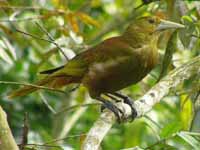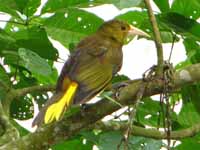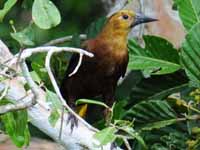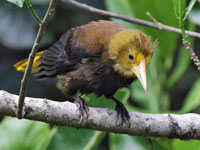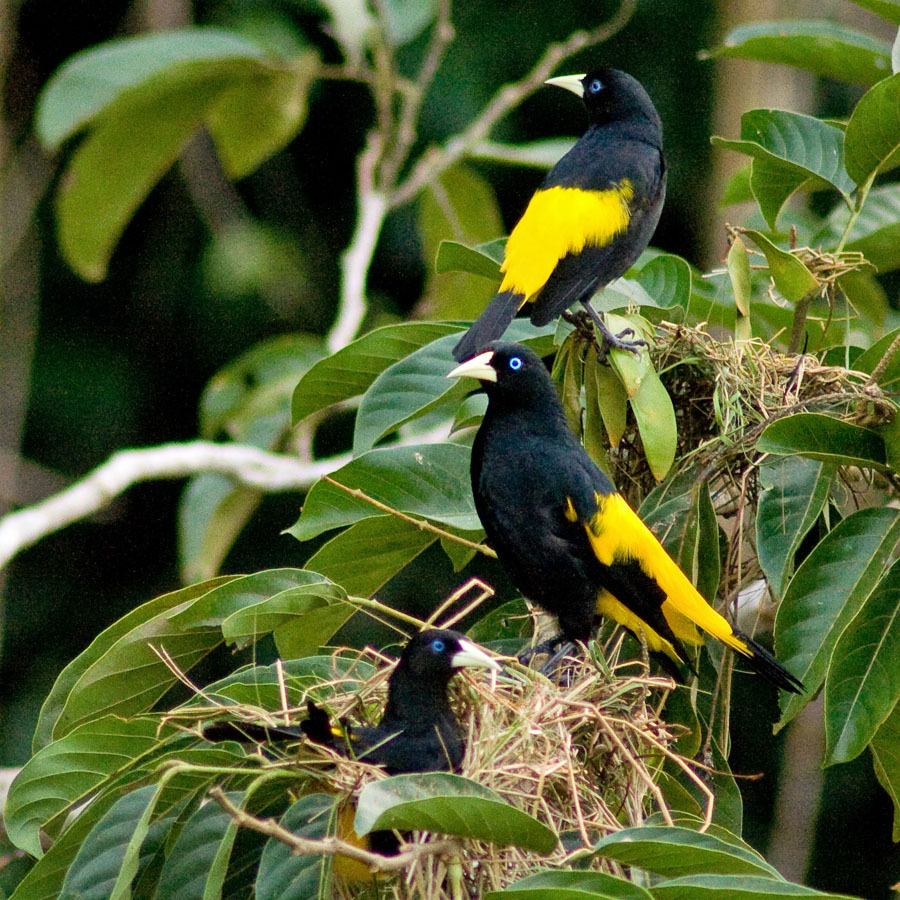THE WORLD BIRDS - An Online Bird Book
ICTERIDAE
Caciques and Oropendolas
Order Passeriformes Family Icteridae
ICTERIDAE
The Icterids are a group of small to medium-sized, often colorful birds, restricted to the New World. Most species have black as a predominant plumage color, often enlivened by yellow, orange or red. The majority of icterid species live in the tropics, although there are a number of temperate forms. They inhabit a range of habitats, including scrub, swamp, forest, and savannah. Temperate species are migratory. Icterids are variable in size, and often display considerable sexual dimorphism. Their size varies 15-52 cm. One unusual adaptation shared is they can open their bills strongly rather than passively, allowing them to force open gaps to obtain otherwise hidden food. Some use their gaping motion to open the skins of fruit to obtain the soft insides, and have long bills adapted to the process. Others such as cowbirds have shorter stubbier bills for crushing seeds. orioles will drink nectar. The nesting habits of these birds are similarly variable.
The Icteridae are described in the following articles: black birds, caciques, cowbirds, grackles, meadow lark, and orioles.
The Icteridae are described in the following articles: black birds, caciques, cowbirds, grackles, meadow lark, and orioles.
Caciques and Oropendolas
Order Passeriformes Family Icteridae
The caciques and oropendolas belong to the proposed Icteridae subfamily Cassicinae.
Caciques are slim birds that occur in South America north to Mexico. They have predominantly black plumage, long tails, and large pointed pale bills. The species range from 20 to 30 cm long with two exceptions. Two of the species in the cacique genus Cacicus are actually name oropendolas! They have been placed in the cacique genus because DNA evidence indicates they are closer to them that the oropendolas. That said, they have oropendola type bills and are longer than the normal cacique - up to 37 cm long.
The Cacicus diet consists of insects, spiders, small vertebrates, fruit, and some nectar. They are colonial breederss and most create long pendulous nests which hang from tree branches. The caciques usually have multiple nests in a tree and very often that tree contains a wasps nest as that seems to provide them protection, They are very vocal, producing a wide range of songs, sometimes including mimicry.
The oropendolas are large birds with long tails. The males and females look similar but the males are usually considerably larger than the female. The males of genus Psarocolius are up to 48 cm long while the females are about 10 cm smaller than the males. In some species the female weighs only half the male's weight. Aside from being larger birds, the oropendolas are similar to the caciques: they eat insects, fruit, and nectar; they breed colonially, and create long pendulous nests.
The only cacique or oropendola species that is not doing well is the Baudo oropendola which is listed as Vulnerable due to its limited range which has ongoing logging.
Genus Amblycercus - 1 Species
Cacique,_Yellow-billed Amblycercus holosericeus
Description: The yellow-billed cacique has all black plumage. It has a pale yellow bill, and yellow eyes. The yellow-billed cacique is about 23 cm long. It builds a cup-shaped nest, which is unusual for its family, which mostly builds hanging woven nests. The similar red-rumped cacique and also the scarlet-rumped cacique have blue eyes.
Range: Mexico, Central America, northern South America.
Habitat: Forest, forest edges, and degraded forests.
Diet: Mainly insects and other arthropods. Also some fruit.
Conservation status: Least Concern.
Image by: 1) Jorge Montejo - Mexico 2) Nick Athanas - Mexico 3) Neil Orlando Diaz MartinezRange: Mexico, Central America, northern South America.
Habitat: Forest, forest edges, and degraded forests.
Diet: Mainly insects and other arthropods. Also some fruit.
Conservation status: Least Concern.
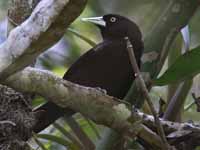
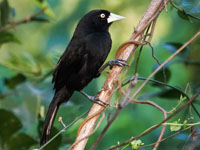
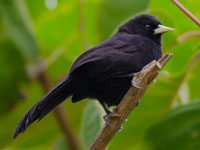
Genus Cacicus
Caciques are slim birds with predominantly black plumage, long tails, and large pointed pale bills. Their diet consists of insects and fruit. They are colonial breeders creating long pendulous nests which hang from tree branches. Caciques occur in South America north to Mexico.
Cacique,_Ecuadorian Cacicus sclateri
Description: The Ecuadorian cacique has black plumage with perhaps a few yellow feathers at the rump. It has blue eyes and a pale bluish bill. The Ecuadorian cacique is 23 cm long.
Range: Mainly Ecuador; also Columbia and Peru.
Habitat: Forest edges, usually found mid-way up the tree.
Diet: Insects and also fruit.
Conservation status: Least Concern.
Image by: 1) Alphonse DuboisRange: Mainly Ecuador; also Columbia and Peru.
Habitat: Forest edges, usually found mid-way up the tree.
Diet: Insects and also fruit.
Conservation status: Least Concern.
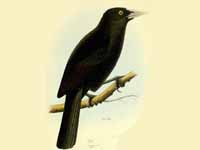
Cacique,_Golden-winged Cacicus chrysopterus
Description: The golden-winged cacique has all black plumage except for golden wings and a yellow patch on the rump. It has pale yellow eyes and a pale bluish-grey legs. The golden-winged cacique is about 20 cm long. The similar yellow-rumped cacique has yellow on the upperpart of tail.
Range: Argentina, Bolivia, Brazil, Paraguay, and Uruguay.
Habitat: Montane forests, forest edges, degraded forests.
Diet: Insects, fruits, nectar. Also small vertebrates.
Conservation status: Least Concern.
Image by: 1, 2) Dario Sanches 3) Nick Athanas - Brazil 4) Claudio_TimmRange: Argentina, Bolivia, Brazil, Paraguay, and Uruguay.
Habitat: Montane forests, forest edges, degraded forests.
Diet: Insects, fruits, nectar. Also small vertebrates.
Conservation status: Least Concern.
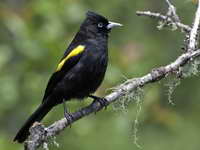
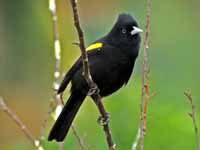
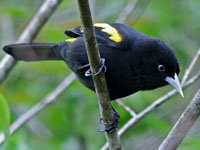
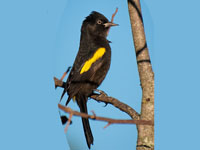
Cacique,_Mountain Cacicus chrysonotus Found:
Description: The mountain cacique has a yellow rump and median back stripe; otherwise the plumage is black. Northern populations have blue eyes and southern have yellow eyes. The northern population also has a yellow wing stripe. It may be separated into 2 species. The mountain cacique is about 28 cm long.
Range: Western South America.
Habitat: Canopy and eges of humid montane forests.
Diet: Insects, fruit, and nectar.
Conservation status: Least Concern.
Image by: 1) Orbigny 2) Andy Morffew - Ecuador 3) Arley VargasRange: Western South America.
Habitat: Canopy and eges of humid montane forests.
Diet: Insects, fruit, and nectar.
Conservation status: Least Concern.
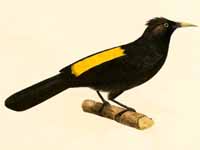
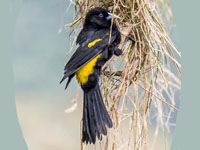
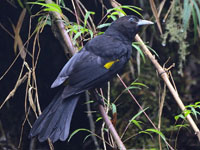
Cacique,_Red-rumped Cacicus haemorrhous
Description: The red-rumped cacique has mainly glossy black plumage. It has a red lower back and rump, blue eyes, and an ivory bill. The male red-rumped cacique is about 29 cm long and the female about 25. The similar scarlet-rumped cacique has red only on its rump. The similar yellow-billed cacique has pale yellow eyes.
Range: South America.
Habitat: Lowland forests, degraded forests, and swamps.
Diet: Insects, fruits, nectar, small vertebrates.
Conservation status: Least Concern.
Image by: 1) Benito Serafini 2) Greg Hume - Cincinnati 3) Ulrich_Peters 4) Claudio Timm Range: South America.
Habitat: Lowland forests, degraded forests, and swamps.
Diet: Insects, fruits, nectar, small vertebrates.
Conservation status: Least Concern.
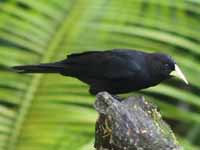
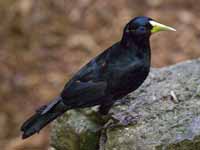
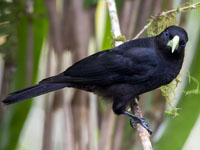
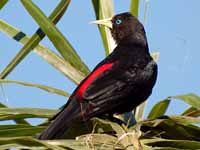
Cacique,_Scarlet-rumped Cacicus uropygialis
Description: The scarlet-rumped cacique has mainly glossy black plumage, a scarlet rump, blue eyes, and an ivory or pale yellow bill. The scarlet-rumped cacique is 25 to 29 cm long with the males larger than the females. The similar red-rumped cacique has red in the center of its back; the solitary black cacique has dark eyes; and the yellow-billed cacique has pale yellow eyes.
Range: Panama and along the Andes in western South America.
Habitat: Montane forests edges and clearings.
Diet: Insects, fruits, nectar.
Conservation status: Least Concern.
Image by: 1) Andy Reago & Chrissy McClarren 2, 3) HarmonyOnPlanetEarth - Panama Range: Panama and along the Andes in western South America.
Habitat: Montane forests edges and clearings.
Diet: Insects, fruits, nectar.
Conservation status: Least Concern.
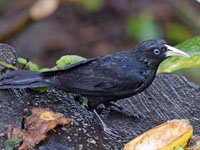
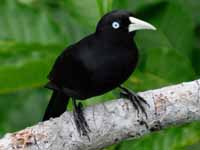
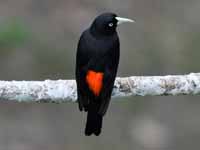
Cacique,_Selva Cacicus koepckeae
Description: The Selva cacique has mainly black plumage plus a yellow rump. It has bluish-white eyes and bill. The Selva cacique is about 23 cm long.
Range: Peru.
Habitat: Subtropical or tropical moist lowland forests preferring to be near rivers and streams.
Diet: Insects and fruit.
Conservation status: It is listed as Near Threatened because its rainforest is being reduced in extent for agricultural purposes.
Range: Peru.
Habitat: Subtropical or tropical moist lowland forests preferring to be near rivers and streams.
Diet: Insects and fruit.
Conservation status: It is listed as Near Threatened because its rainforest is being reduced in extent for agricultural purposes.
Cacique,_Solitary_Black Cacicus solitarius
Description: The solitary black cacique has all black plumage. It has dark eyes and a large white, chisel-shaped bill. It is so name because if does not join flocks of birds. The solitary black cacique is about 27 cm long and the female is about 3 cm shorter. The similar Ecuadorian cacique is smaller and in a restricted range. The scarlet-rumped cacique has blue eyes.
Range: Much of South America.
Habitat: Prefers to be in trees or undergrowth close to rivers and swamps.
Diet: Insects, frogs and other small invertebrates. Also fruits and nectar.
Conservation status: Least Concern.
Image by: 1, 2) Victoria DA 3) Nick Athanas - Brazil 4) Francesco_Veronesi - BrazilRange: Much of South America.
Habitat: Prefers to be in trees or undergrowth close to rivers and swamps.
Diet: Insects, frogs and other small invertebrates. Also fruits and nectar.
Conservation status: Least Concern.
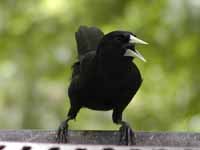
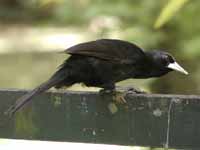
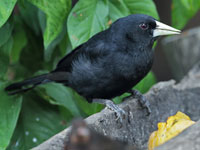
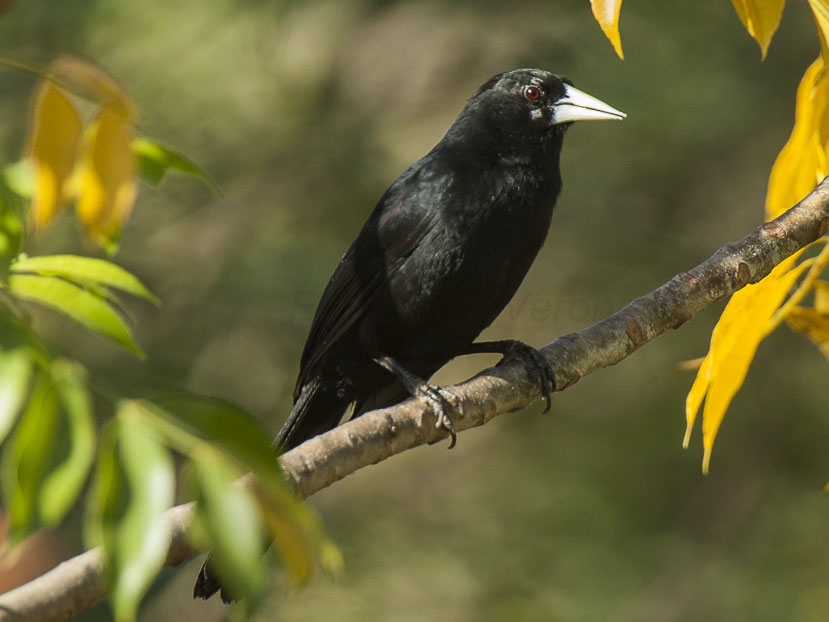
Cacique,_Yellow-rumped Cacicus cela
Description: The yellow-rumped cacique has mainly black plumage. It has a yellow rump, tail base, and yellow wing coverts. The eyes are blue and the bill is pale yellow. The male yellow-rumped cacique is about 28 cm long and the female 23 cm. It is a colonial breeder, with up to 100 bag-shaped nests in a tree. The similar golden-winged cacique has no yellow on its tail.
Range: Panama south to Bolivia, Peru, central Brazil.
Habitat: Open woodland or cultivation with large trees.
Diet: Insects, fruit.
Conservation status: Least Concern.
Image by: 1, 2) Dick Daniels - the North Carolina Zoo 3) Vladimir_Rebellon_Palmezano - Columbia 4) Nick Athanas - Ecuador Range: Panama south to Bolivia, Peru, central Brazil.
Habitat: Open woodland or cultivation with large trees.
Diet: Insects, fruit.
Conservation status: Least Concern.
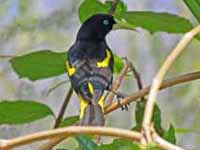
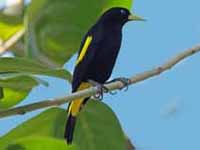
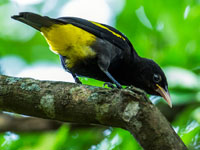
Oropendola,_Band-tailed Cacicus latirostris
Description: The band-tailed oropendola, also known as the band-tailed cacique, has a dark chestnut nape and upper-back. The dark chestnut can appear to be black without good lighting. It has a yellow tail with black edges and tail end; that tail end resulting in it name. The rest of the plumage is black. It has pale blue eyes and a usually ivory colored bill. The male is about 33 cm long and the female 25 cm.
Range: Western Amazon in Brazil, Colombia, Ecuador, Peru.
Habitat: Near rivers in both swampy forests and forest up to 300 m.
Diet: Insects and other arthropods, fruits, nectar.
Conservation status: Least Concern.
Range: Western Amazon in Brazil, Colombia, Ecuador, Peru.
Habitat: Near rivers in both swampy forests and forest up to 300 m.
Diet: Insects and other arthropods, fruits, nectar.
Conservation status: Least Concern.
Oropendola,_Casqued Cacicus oseryi Found: Bolivia, Brazil, Ecuador, Peru
Description: The casqued oropendola has chestnut upperparts. It has an olive-yellow breast, same for the neck sides, a greyish throat, and white eyes. The casque refers to a protrusion from the top of the bill towards the crown. All oropendola have a casque, but this species has the most pronounced. The male casqued oropendola is about 37 cm long and the female 29 cm.
Range: Mainly eastern Ecuador and eastern Peru. Also Bolivia and Brazil.
Habitat: Moist lowland forests.
Diet: Probably insects, fruits, nectar.
Conservation status: Least Concern.
Image by: 1)Casteinau 2) Nick Athanas - EcuadorRange: Mainly eastern Ecuador and eastern Peru. Also Bolivia and Brazil.
Habitat: Moist lowland forests.
Diet: Probably insects, fruits, nectar.
Conservation status: Least Concern.
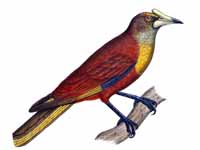
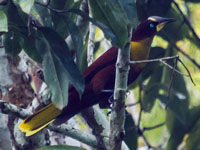
Genus Cassiculus - 1 species
This is the northmost cacique
Cacique,_Yellow-winged Cassiculus melanicterus
Description: The yellow-winged cacique has mainly black plumage. It has yellow wings, rump, and tail. The male yellow-winged cacique is abut 32 cm long and the female about 4 cm less. The range of the similar yellow-rumped cacique does not overlap with the yellow-winged.
Range: Northern Guatemala, west coast Mexico.
Habitat: Dry forests and degraded forests.
Diet: Insects, fruits, nectar. Probably some small vertebrates.
Conservation status: Least Concern.
Image by: 1() Alexander_Carrillo 2) Don Loarie 3) Ron Knight 4) Nick_Athanas - Mexico Alexander_CarrilloRange: Northern Guatemala, west coast Mexico.
Habitat: Dry forests and degraded forests.
Diet: Insects, fruits, nectar. Probably some small vertebrates.
Conservation status: Least Concern.
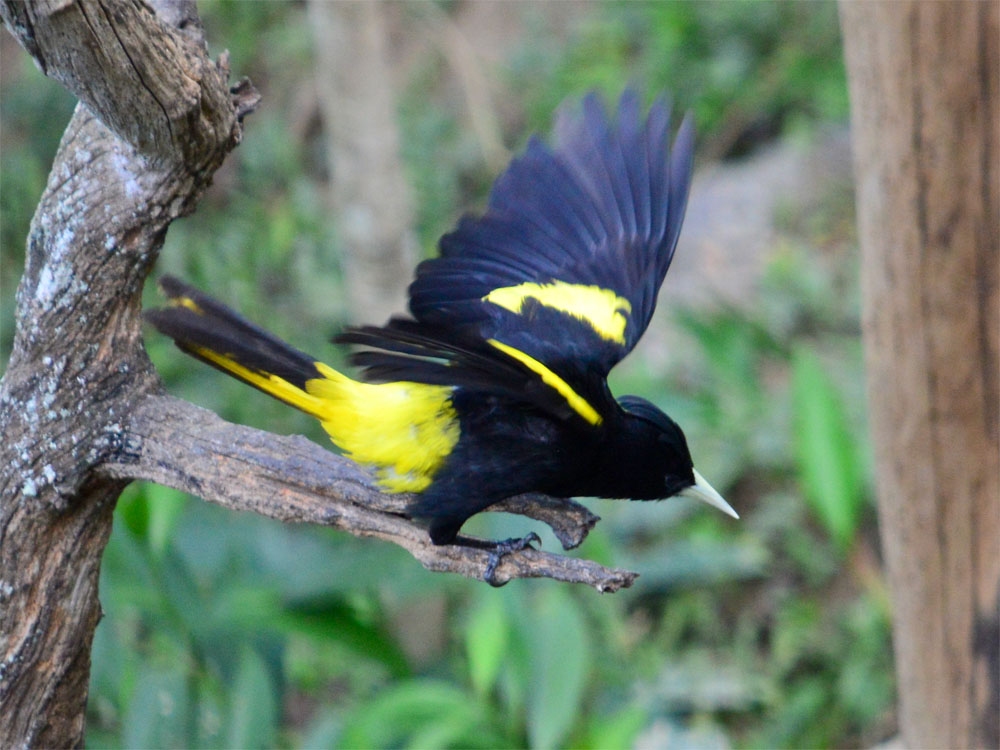
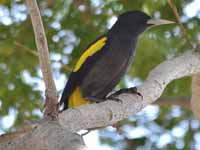
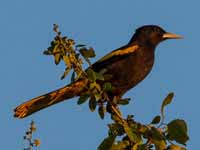
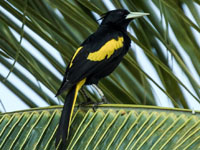
Genus Psarocolius
The oropendolas have long pointed bills; long tails with at least some bright yellow. Like the orioles they are colonial breeders and have long basket-like nests. They eat insects and fruit.
Oropendola,_Baudo Psarocolius cassini
Description: The Baudo oropendola has chestnut upperparts. It has a black head, neck, and underparts;. The tail is golden with a black center; the heavy triangular bill has a yellow tip. The Baudo Oropendola is about 46 cm long and the female about 30.
Range: Columbia.
Habitat: River valleys, usually at the edge of rainforests.
Diet: Insects, fruit.
Conservation status: It is listed as Vulnerable due to its limited range which has ongoing logging.
Image by: 1) Nick Athanas Range: Columbia.
Habitat: River valleys, usually at the edge of rainforests.
Diet: Insects, fruit.
Conservation status: It is listed as Vulnerable due to its limited range which has ongoing logging.
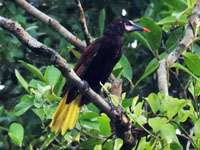
Oropendola,_Black Psarocolius guatimozinus
Description: The black oropendola has a black upper back and a dark chestnut lower back, The underparts are black. It has bare blue and pink facial patches. The dark bill has an orange tip and the tail is yellow with a black center. The male black oropendola is about 46 cm long while the female is about 40. The similar Montezuma oropendola. a has chestnut upperparts.
Range: Columbia, Panama.
Habitat: Humid forests up to 800 m.
Diet: Insects, fruit. Probably also small vertebrates and nectar.
Conservation status: Least Concern.
Image by: 1) John Gerrard Keulemanns 2) Jacksnipe1990Range: Columbia, Panama.
Habitat: Humid forests up to 800 m.
Diet: Insects, fruit. Probably also small vertebrates and nectar.
Conservation status: Least Concern.
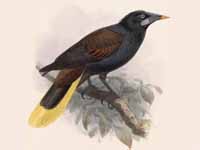
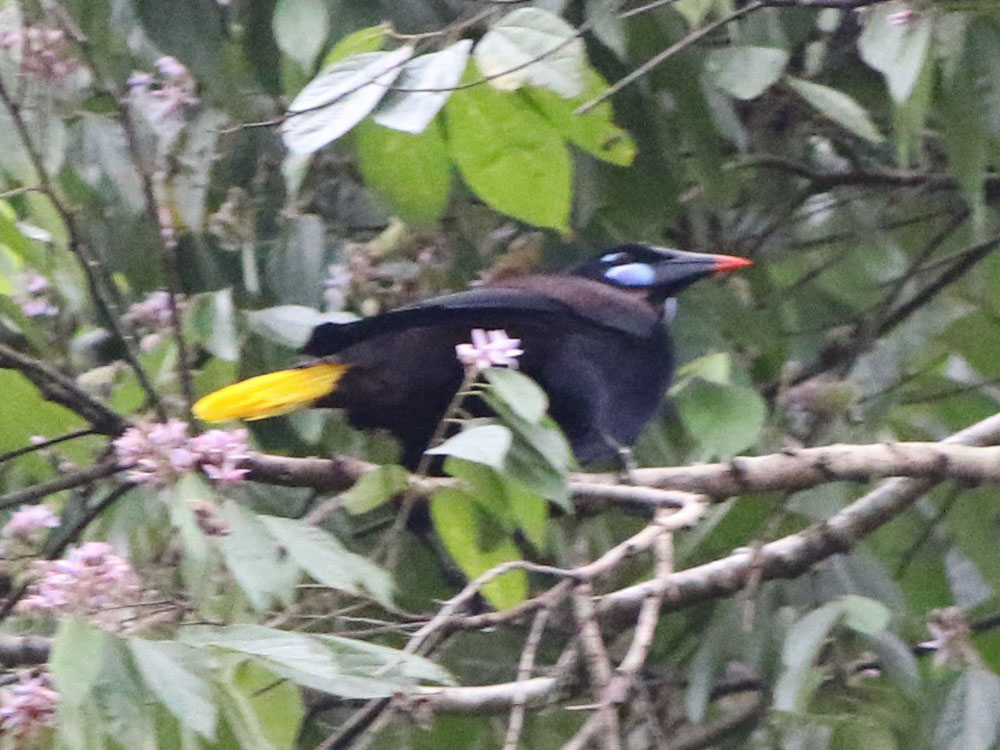
Oropendola,_Chestnut-headed Psarocolius wagleri
Description: The chestnut-headed oropendola has mainly black plumage. It has a chestnut head, rump, and upper-breast. The eyes are blue and the whitish bill has a bulbous area at base of the upper mandible. It has a yellow tail with black central feathers. The chestnut-headed oropendola is 35 cm long and the female is 28. They breed colonially with many nests in a tree; tmales are poligomous. Giant cowbirds are brood parasitic towards them. The similar crested oropendola does not have that bulbous bill area.
Range: Mexico to northwest South America.
Habitat: Forest canopy, edges, and old plantations.
Diet: Insects, fruits, berries.
Conservation status: Least Concern.
Image by: 1) Kate and Sam - Costa Rica 2) Gaby Schulemann-Maier - Costa Rica 3) Nick Athanas - PanamaRange: Mexico to northwest South America.
Habitat: Forest canopy, edges, and old plantations.
Diet: Insects, fruits, berries.
Conservation status: Least Concern.
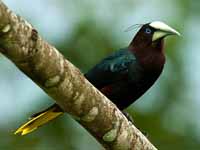
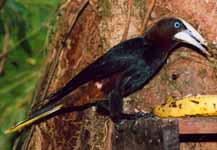
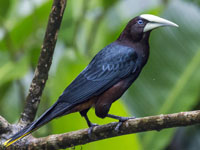
Oropendola,_Crested Psarocolius decumanus
Description: The crested oropendola has mainly black plumage. It has a chestnut rump, blue eyes, whitish bill, and yellow tail with black central feathers. There is a difficult to see crest. The male crested oropendola is about 47 cm long and the female is 10 cm shorter. The similar chestnut-headed oropendola has a bulbous area at base of upper mandible.
Range: Panama to Colombia and south to northern Argentina. Also Trinidad and Tobago.
Habitat: Forest edges, second growth forests, plantations with large trees.
Diet: Insects, fruits, seeds. Also some nectar.
Conservation status: Least Concern.
Image by: 1) Alastair Rae 2)
Dominic Sherony 3) Dick Daniels - National Aviary 4) Sandy Cole - San Diego Zoo Range: Panama to Colombia and south to northern Argentina. Also Trinidad and Tobago.
Habitat: Forest edges, second growth forests, plantations with large trees.
Diet: Insects, fruits, seeds. Also some nectar.
Conservation status: Least Concern.
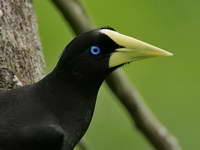
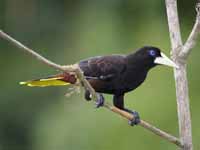
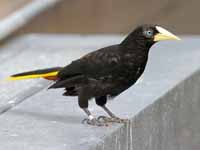
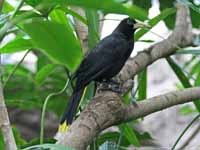
Oropendola,_Dusky-green Psarocolius atrovirens Found: Bolivia, Peru
Description: The dusky-green oropendola has mainly dark green plumage. It has a greenish-white bill, rufous brown rump, and yellow tail with green central feathers. The male dusky-green oropendola is about 42 cm long and the female 33.
Range: East slopes of the Andes from central Peru to Bolivia. It ranges from 800 to 2600 meters.
Habitat: Montane forests, along river canyons, plantations with fruit available.
Diet: Probably insects, fruits, nectar.
Conservation status: Least Concern.
Image by: 1) Paul Seligman 2) Joao_Quental 3) Claudio_TimmRange: East slopes of the Andes from central Peru to Bolivia. It ranges from 800 to 2600 meters.
Habitat: Montane forests, along river canyons, plantations with fruit available.
Diet: Probably insects, fruits, nectar.
Conservation status: Least Concern.
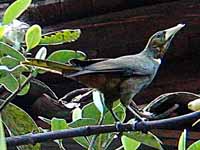
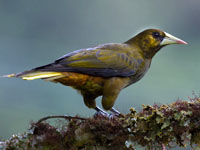
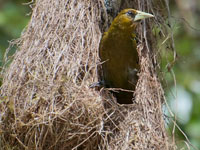
Oropendola,_Green Psarocolius viridis Found:
Description: The green oropendola has a pale olive-green back, head, amd breast. It has greyish-green wings, chestnut rump, and chestnut underparts. It has blue eyes and pale bill with an orange tip. The male green oropendola is about 43 cm long and the female 37 cm.
Range: In the Amazon basin of northern South America: Colombia, Venezuela, Guyana, Surinam, French Guiana, Brazil, Ecuador, Bolivia and Peru.
Habitat: Mainly in undisturbed forests.
Diet: Insects, fruits.
Conservation status: Least Concern.
Image by: 1) Arjan Haverkamp 2) Dick Daniels - National Aviary 3) Francesco_Veronesi - Peru 4) Ingrid Torres de Macedo - BrazilRange: In the Amazon basin of northern South America: Colombia, Venezuela, Guyana, Surinam, French Guiana, Brazil, Ecuador, Bolivia and Peru.
Habitat: Mainly in undisturbed forests.
Diet: Insects, fruits.
Conservation status: Least Concern.
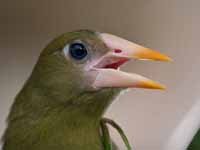
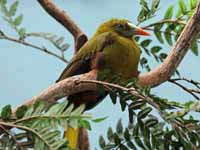
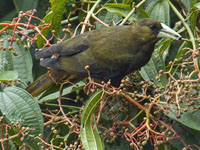
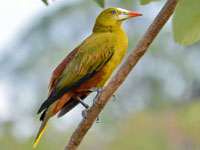
Oropendola,_Montezuma Psarocolius montezuma Found: Central America
Description: The Montezuma oropendola has chestnut upperparts and black underparts. It has bare blue and light pink facial patches. The bill is black with an orange tip and the tail is yellow with dark central feathers. The male Montezuma oropendola is about 47 cm long while the female is about 38. This oropendola is able to keep cowbirds from laying eggs in their nest. The similar black oropendola has a black upper back.
Range: Southeast Mexico, Nicaragua, Honduras, Costa Rica, and Panama.
Habitat: Lowland forest edges and clearings. Also plantations.
Diet: Arthropods, small invertebrates, fruits, nectar.
Conservation status: Least Concern.
Image by: 1) Dominic Sherony
2)
Roland van Stokkom - Costa Rica 3) Andy_Morffew - Costa Rica 4) Paulo Philippidis -
Costa Rica Range: Southeast Mexico, Nicaragua, Honduras, Costa Rica, and Panama.
Habitat: Lowland forest edges and clearings. Also plantations.
Diet: Arthropods, small invertebrates, fruits, nectar.
Conservation status: Least Concern.
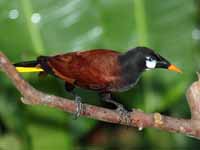
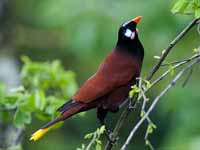
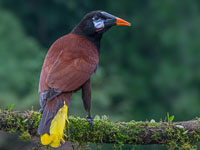
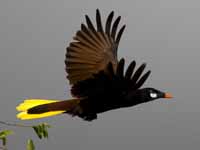
Oropendola,_Olive Psarocolius bifasciatus
Description: The olive oropendola has an olive head, neck, and breast. Some subspecies have a darker head. It has a brown back, wings, belly, and eyes. There is bare pink facial skin and a black bill with an orange tip. The male olive oropendola is up to 47 cm long while the female is up to 38 cm long. Females weight around 200 gm and males are more than twice that weight! The similar green oropendola has a pale bill with an orange tip.
Range: Humid lowland forests of the Amazon Basin.
Habitat: Lowland forests with tall trees and nearby plantations.
Diet: Northern and central South America.
Conservation status: Least Concern.
Image by: 1, 2) Ross Tsai 3) Nick Athanas - BrazilRange: Humid lowland forests of the Amazon Basin.
Habitat: Lowland forests with tall trees and nearby plantations.
Diet: Northern and central South America.
Conservation status: Least Concern.
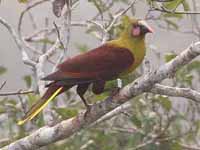
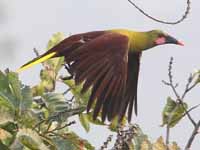
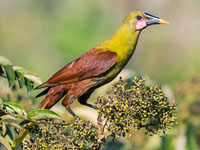
Oropendola,_Russet-backed Psarocolius angustifrons Found: South America
Description: The russet-backed oropendola has an olive-brown head, neck, and back. The outer tail feathers are yellow. Depending on the subspecies, the rest of the plumage is either olive-brown or dark brown. Lowland birds have pale bills while highland birds have black bills. The male russet-backed oropendola is 44 to 48 cm long while the female is about 10 cm shorter.
Range: North-central South America, mainly along the Andes.
Habitat: From lowland forest to about 2500 m. Forest edges and clearings; also plantations.
Diet: Fruits, insects, flowers, nectar.
Conservation status: Least Concern.
Image by: 1) Barloventomagico - Venezuela 2) Cristóbal Alvarado Minic - Venezuela 3) Vince Smith - Ecuador 4) Nick Athanas - Peru Range: North-central South America, mainly along the Andes.
Habitat: From lowland forest to about 2500 m. Forest edges and clearings; also plantations.
Diet: Fruits, insects, flowers, nectar.
Conservation status: Least Concern.
